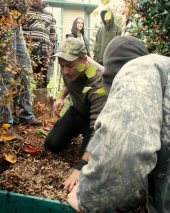Well, I honestly haven't been thinking about it in terms of towns/counties, but to answer your question I see Rutland, Windsor, Bennington and Windham as being "Southern" Vermont. The idea behind creating a "Southern Vermont" group was to draw together anyone who remotely considers themselves to reside at the southern-most end of Vermont. There's a whole lot of neat permaculture and/or regenerative agriculture activity I know of in the Central and Northern parts of Vermont, but I haven't encountered much – nor any dedicated online platform to connect folks in this area – in the Southern end, where I am living now. I want to help change that! I just don't feel like driving north (or south to Western Mass or New York) all the time; I want more permaculture-related activity happening right here. I'm near Brattleboro, for reference.
As I see it, this needn't be exclusive to Vermont residents, nor to residents of any particular towns/counties. I see it being available as a resource to anybody living NEAR the loosely-defined area of "Southern Vermont" (meaning, it can include folks living just over the state line in Western Massachusetts, New Hampshire or New York).
That said... I ultimately think it'd be neat if "permaculture guilds" (or whatever we want to call these self-organizing groups) were clustered throughout the Northeast based not on state boundaries, nor on their sharing an #-mile radius from an urban center, but by physiographic region (
http://academics.smcvt.edu/vtgeographic/textbook/physiographic/physiographic_regions_of_vermont.htm). If indeed these physiographic regions represent distinctly different sections of the landscape we call Vermont, I feel like it'd beneficial to us (as far as productive ecological restoration is concerned) to ally ourselves with other folks in the same regions and collectively share best practices for producing [____ form of food, fiber, fuel, shelter, etc.] in our particular physiographic region. Different regions will (I suspect, I could be totally wrong here), TEND to be best-suited to particular forms/methods of land use. Anyone else have thoughts on this? Am I crazy?
For now, to fully answer this question, the attached image with Google Earth roughly represents what I see "Southern Vermont" to mean – parts of nearby states included. I hope this clarifies!








